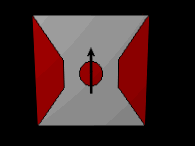
Materials Research Science and Engineering Center: Faculty Publications
Document Type
Article
Date of this Version
5-1-2005
Abstract
Symmetry properties of the Green function in magnetic multilayers with noncollinear magnetization of the layers are investigated on the basis of the transfer matrix method. The Green function symmetric with respect to permutation of its arguments is constructed. It is shown how the boundary conditions can be imposed on this Green function.
We have proposed a constructive way to build a symmetric one-electron GF for the magnetic multilayer with magnetization in the plane of the layers. To build this GF we solved the following problems: finding the solution of the systems of differential equations of general form; matching the solutions on the interfaces; imposing proper boundary conditions and employing free parameters to get a symmetric function with respect to permutation of the variables z → z' and σ → σ '. Our consideration is valid for complex wave vectors which allows for extending this method to systems with insulating layers. Also our consideration can be applied to systems with finite lateral dimensions like magnetic nanowires. Note that the described matching procedure, as well as the procedure providing for the boundary conditions, can be applied for a layer potential which differs from the usual rectangular potential. In contrast, the possibility of imposing some symmetry condition requires additional investigation. The proposed GF is useful for the investigation of electronic transport properties of magnetic multilayers. Though our consideration was performed for specific boundary conditions which are typical for current-perpendicular-to-plane geometry, the proposed approach can be applied to a multilayer of finite transverse dimension with zero boundary conditions on the outer interfaces.


Comments
Published in Journal Of Physics A: Mathematical And General 38 (17 June 2005), pp. 5547–5556. doi:10.1088/0305-4470/38/24/008 Online at http://stacks.iop.org/JPhysA/38/5547 Copyright © 2005 Institute Of Physics Publishing. Used by permission